 |
 |
 |
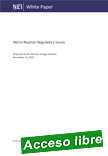 |
Micro-Reactor Regulatory Issues
Nuclear Energy Institute. November 2019
Nuclear Energy Institute. November 2019
Micro-reactors are very small nuclear reactors that are well suited to serve the power needs for markets that currently do not have access to clean, reliable, resilient and affordable energy, including remote areas and micro-grids. Micro-reactor technology and designs are rapidly maturing and the first micro-reactor applications are expected to be submitted to the U.S. Nuclear Regulatory Commission (NRC) in 2020.
|
The purpose of this report is to discuss changes in the way micro-reactors are licensed and regulated. This also identifies the need to address several policy and technical issues. Timely NRC consideration and feedback on the policy and technical issues associated with a performance-based, consequence-oriented regulatory framework is needed to inform design of micro reactors as well as business decisions affecting licensing and certification of micro-reactors over the next few years.
|
 |
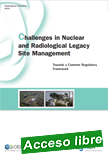 |
Challenges in Nuclear and Radiological Legacy Site Management: Towards a Common Regulatory Framework
OECD/Nea – Nuclear Energy Agency, 2019. English. NEA No. 7419
Many countries are dealing with challenges stemming from nuclear and radiological legacy sites. In particular, managing these sites in an open and transparent fashion while taking into account the views of all relevant stakeholders and building confidence in the solutions adopted is an ongoing challenge. This report provides information on the challenges and lessons learnt in legacy management and regulation based on practical experience documented in 13 case studies and site visits conducted by the OECD Nuclear Energy Agency.
|
A preliminary framework for a stepwise process to help reach an accepted and sustainable end-state is proposed based on this experience. The complex challenges and interactions among stakeholders in progressing in a harmonised, step-by-step manner are also examined in depth. The report concludes with recommendations for future international collaborative work to improve and test the preliminary framework, and to examine and address the complexity of the relevant interactions.
|
 |
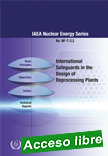 |
International Safeguards in the Design of Reprocessing Plants
IAEA Nuclear Energy Series NF-T-3.2 | STI/PUB/1866 | Date published: 2019 | 62 p.
This publication is part of a series that aims to inform nuclear facility designers, vendors, operators and State governments, about IAEA safeguards and how associated requirements can be considered early in the design phase of a new nuclear facility. This particular publication is applicable to the design of spent nuclear fuel reprocessing plants.
|
Safeguards by design dialogue undertaken early in the design and construction of reprocessing plants, facilitates the implementation of safeguards throughout all the lifecycle stages of the facility. The potential to reduce costs, avoid retrofits and achieve efficiencies both for the operator and for IAEA Member States, are important drivers for the early consideration of safeguards in a nuclear facility design project.
|
 |
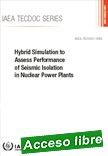 |
Hybrid Simulation to Assess Performance of Seismic Isolation in Nuclear Power Plants
IAEA TECDOC No. 1888 | Date published: 2019 | 218 p.
Seismic isolation technology has the potential to significantly reduce the overall risk posed by earthquake ground motions to nuclear power plants. A testing programme is an integral part of a seismic isolation project. Not only must the isolating devices be characterized for design purposes, but also validation of the analytical procedures used in design is required. Hybrid simulation is a testing technique which is a good candidate to experimentally assess the behaviour of an isolation system.
|
The method combines the computation of the response of the isolated structure with the experimental determination of the behaviour of full-scale isolators under the demand imposed by the movement of ground and structure. This publication contributes to the assessment of the method as a tool for the design and safety demonstration of base-isolated nuclear facility buildings.
|
 |
 |
Thorium Resources as Co- and By-products of Rare Earth Deposits
IAEA TECDOC No. 1892 | Date published: 2019 | 80 p.
Research has been published over the past few decades on the possible use of thorium in various nuclear power reactor types. Therefore, it is worthwhile to analyse the supply situation for additional thorium generated as a by-product of commodities produced for non-nuclear purposes. This publication provides information on the natural occurrence of thorium, the geology of thorium and potential thorium resources.
|
It presents an overview of exploration and evaluation of projects, including studies for project feasibility, principles of ore processing, as well as market and production scenarios. Selected examples of deposits containing thorium as a potential co-product or by-product are presented as case studies.
|
 |
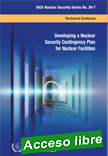 |
Developing a Nuclear Security Contingency Plan for Nuclear Facilities
IAEA Nuclear Security Series No. 39-T | STI/PUB/1873 | Date published: 2019 | 33 p.
This publication provides guidance to States, competent authorities and operators on how to develop and maintain contingency plans for nuclear facilities. It can be used as a starting point for organizations that have not previously prepared or developed contingency plans, as well as a reference for organizations that wish to validate or improve their existing contingency plans.
|
It is intended for use by senior managers and security specialists charged with developing such plans and by competent authorities responsible for their oversight.
|
 |
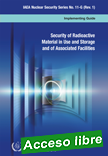 |
Security of Radioactive Material in Use and Storage and of Associated Facilities
IAEA Nuclear Security Series No. 11-G (Rev.1) |STI/PUB/1840 |Date published: 2019 | 105 p.
This new revision provides guidance to States and their competent authorities on how to establish or improve, implement, maintain and sustain the elements of the nuclear security regime related to radioactive material, associated facilities and activities, with particular emphasis on the development of regulatory requirements.
|
The publication applies to the security of radioactive material in use or in storage as well as associated facilities and associated activities and assists Member States in their regimes against unauthorized removal of the radioactive material or sabotage performed with the intent to cause harmful radiological consequences.
|
 |
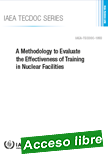 |
A Methodology to Evaluate the Effectiveness of Training in Nuclear Facilities
IAEA TECDOC No. 1893 | Date published: 2019 | 54 p.
The objective of this publication is to present a set of training standards and conditions, based on the internationally accepted Systematic Approach to Training - SAT methodology, which can be used by any nuclear facility to objectively evaluate the quality of its training, learning and development1 infrastructure, processes and programmes. The publication also offers guidance and options for peer review processes,
|
including IAEA assistance, and guidance on creating independent validation bodies, although the main focus is the self-assessment methodology as this is key to self-awareness and improvement.
|
 |
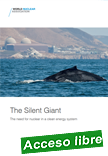 |
The Silent Giant -The need for nuclear in a clean energy system
World Nuclear Association | 2019. | 12 p.
In a world centred on short-term fixes, many of the traits that make nuclear energy a key player in the transition to a sustainable world are not properly valued and often taken for granted. Reflecting on the popular discourse in the world of energy politics it would seem that renewables, and renewables alone, will be responsible for, and capable of, delivering a zero-carbon energy system – and that it is just a matter of time.
|
The reality today is that both global carbon dioxide emissions and fossil fuel use are still on the rise. This does not only make the battle against climate change much harder, but also results in hundreds of thousands of pollution deaths every year. Energy is the essential agent for promoting human development, and global demand is projected to increase significantly in the coming decades. Securing access to modern and affordable energy is essential for lifting people out of poverty, and for promoting energy independence and economic growth. Nuclear energy is a proven solution with a long and well-established track record. Nuclear reactors – a grand total of 445 in 30 countries – are the low-carbon backbone of electricity systems, operating in the background, day in and day out, often out of sight and out of mind. Capable of generating immense amounts of clean power, they are the silent giants upon which we rely daily.
|
 |
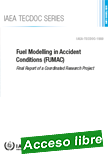 |
Fuel Modelling in Accident Conditions (FUMAC)
Final Report of a Coordinated Research Project
IAEA TECDOC No. 1889 | Date published: 2019 | 180 p.
This publication summarizes the findings and conclusions of an IAEA coordinated research project (CRP) on fuel modelling in accident conditions, which was initiated under the IAEA Action Plan on Nuclear Safety following the Fukushima accident. The overall aim of the project was to analyse and better understand fuel behavior in accident conditions, with a focus on loss of coolant accidents.
|
In the course of the project the participants used a mixture of data derived from accident simulation experiments, in particular data designed to investigate the fuel behaviour during design basis accident and design extension conditions. They carried out calculations on priority cases selected from a matrix of cases identified at the first research coordination meeting and designed to support their individual priorities. These priority cases were chosen as the best available to help determine which of the many models used in the codes best reflect reality. The CRP provided an ideal platform to compare their code results with others and especially with experimental data, to which they otherwise would not have had access. The achievements made within this CRP fostered new collaborations and enhanced the development and improvement of common models and highlighted differences in the interpretation of some experiments and therefore in the use of the codes ? the so-called user effects.
|
 |
| |
|
|

|
|
|
| |
|
|
| |
| |
|
|
| |
| |
|
|
| |
| |
|
|
|
| |
| |
